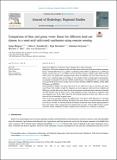| dc.description.abstract | Study area
Kikuletwa catchment, Upper Pangani River Basin, Tanzania.
Study focus
This study compared yearly blue and green water fluxes using four different methods: Senay’s method (SN) (Senay et al., 2016), van Eekelen method (EK) (van Eekelen et al., 2015), the Budyko method (Simons et al., 2020) and the Soil Water Balance (SWB) model (FAO and IHE Delft, 2019). The yearly blue and green water fluxes of different Land Use Land Cover (LULC) classes were estimated using an ensemble of seven global remote sensing-based evapotranspiration products (Ensemble ET) and the CHIRPS rainfall dataset. The Ensemble ET was created from seven global RS-based surface energy balance models (GLEAM, CMRS-ET, SSEBop, ALEXI, SEBS, ETMonitor and MOD16).
New hydrological insights
Our study found that the EK method was able to map blue and green water fluxes with realistic results for irrigated and non-irrigation cultivated areas. Budyko and SWB gave too high blue water fluxes for the non-irrigated agricultural areas, whereas the Budyko and SWB models were not able to show a clear difference in blue-water fluxes in irrigated versus non-irrigated areas. On the other hand, the SN method estimated no blue water fluxes in more than half of the identified irrigated areas.
Three of the four methods estimate the highest blue water fluxes (318–582 mm/y) in forested areas, while the SWB model estimates the highest blue water fluxes in irrigated banana and coffee (278 mm/y). Overall, we conclude that the EK method yielded the most realistic spatial pattern of blue-water fluxes when compared to the irrigated land use map, whereas SWB could be considered after further calibration if higher temporal data resolution (e.g. monthly) is required. | en_US |

